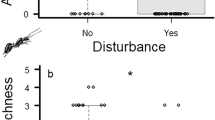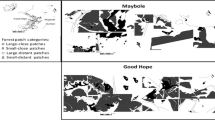Abstract
Large-scale (>100 m2/day) raids by tropical army ants have been linked to litter ant patchiness and diversity. In three Neotropical forests, densities of litter ants vary 10–20 fold at the 1-m2 scale. A survey of Barro Colorado Island. Panama, revealed that most army ant raids also occur on a 1-m2 scale with fronts ≤1 m wide. To explore the role that such small scale disturbance may play in creating litter ant patchiness, all litter ant nests were removed from 1-m2 plots. Control and disturbance plots were resampled 3 months later. In contrast to a previous study of large litter gaps, ant foundresses did not appear to prefer these smaller gaps. Nest densities, species richness, and species composition differed most from controls in a dry hilltop forest in Panama, second most in a wetter ravine forest nearby, and least in a Costa Rican wet forest. Disturbance may not leave a lasting signature in the wetter forests due to higher background levels of disturbance, faster recovery, or both.
Similar content being viewed by others
References
Adams E, Tschinkel W (1995) Density-dependent competition in fire ants: effects on colony survivorship and size variation. J Anim Ecol 64: 315–324
Brokaw N (1985) Gap-phase regeneration in a tropical forest. Ecology 66: 682–687
Byrne M (1994) Ecology of twig-dwelling ants in a wet lowland tropical forest. Biotropica 26: 61–72
Carlson DM, Gentry JB (1973) Effects of shading on the migratory behavior of the Florida harvester ant, Pogonomyrmex badius. Ecology 54: 452–453
Chao A (1984) Non-parametric estimation of the number of classes in a population. Scand J Stat 11: 265–270
Clark D, Clark D (1984) Spacing dynamics of a tropical rain forest tree: evaluation of the Janzen-Connell model. Am Nat 124: 769–788
Colwell R, Coddington J (1994) Estimating terrestrial biodiversity through extrapolation. Phil Trans R Soc Lond B 345: 101–118
Croat T (1978) Flora of Barro Colorado Island. Stanford University Press, Stanford
Cushman JH, Whitham TG (1991) Competition mediating the outcome of a mutualism: protective services of ants as a limiting resource for membracids. Am Nat 138: 851–865
Cushman JH, Martinsen GD, Mazeroll AI (1988) Density- and size-dependent spacing of ant nests: evidence for intraspecific competition. Oecologia 77: 522–525
Davidson DW (1985) An experimental study of diffuse competition in harvester ants. Am Nat 125: 500–506
Denslow J (1987) Tropical rainforest gaps and tree species diversity. Annu Rev Ecol Syst 18: 431–451
Droual R (1981) Emigrations and defense behavior in the ant Pheidole desertorum Wheeler. Am Zool 21: 947
Droual R (1984) Anti-predator behaviour in the ant Pheidole desertorum: the importance of multiple nests. Anim Behav 32: 1054–1058
Droual R, Topoff H (1981) The emigration behavior of two species of the genus Pheidole (Formicidae: Myrmicinae) Arizona, New Mexico. Psyche 88: 135–150
Fetcher N, Oberbauer S, Strain B (1985) Vegetation effects on microclimate in lowland tropical forest in Costa Rica. Int J Biometeorol 29: 145–155
Franks N (1980) The evolutionary ecology of the army ant Eciton burchelli on Barro Colorado Island, Panama. University of Leeds, Leeds
Franks NR (1982) Ecology and population regulation in the army ant Eciton burchelli (Barro Colorado Island, Panama). In: E.G. Leigh J, Rand AS, Windsor DM (ed) The ecology of a tropical forest: seasonal rhythms and long-term changes. Smithsonian Institution Press, Washington, pp 389–395
Franks NR, Bossert WH (1983) The influence of swarm raiding army ants on the patchiness and diversity of a tropical leaf litter ant community. In: Sutton EL, Whitmore TC, Chadwick AC (ed) Tropical rain forest: ecology and management. Blackwell, Oxford, pp 151–163
Fretwell S, Lucas HJ (1970) On territorial behavior and other factors influencing habitat distribution in birds. Acta Biotheor 14: 16–36
Gentry A (1988) Changes in plant community diversity and floristic composition on geographical and environmental gradients. Ann Mo Bot Gard 75: 1–34
Gordon DM (1992) Nest relocation in harvester ants. Ann Entomol Soc Am 85: 44–47
Harper J (1967) A Darwinian approach to plant ecology. J Ecol 55: 247–270
Hartshorn G (1978) Tree falls and tropical forest dynamics. In: Tomlinson P, Zimmerman M (ed) Tropical trees as living systems. Cambridge University Press, Cambridge, pp 617–638
Hartshorn G (1983) Introduction to Plants. In: Janzen D (ed) Costa Rican natural history. University of Chicago Press, Chicago, pp 118–157
Hartshorn G, Mammel B (1994) Vegetation types and floristic patterns. In: McDade L, Bawa K, Hespenheide H, Hartshorn G (ed) La Selva: ecology and natural history of a neotropical rain forest. University of Chicago Press, Chicago, pp 73–89
Herbers JM (1986) Nest site limitation and facultative polygyny in the ant Leptothorax longispinosus. Behav Ecol Sociobiol 19: 115–122
Holdridge L, Grenke W, Hatheway W, Liang T, Tosi J (1971) Forest environments in tropical life zones: a pilot study. Pergamon, New York
Hölldobler B, Wilson EO (1990) The ants. Belknap, Cambridge
Horvitz CC, Schemske DW (1990) Spatiotemporal variation in insect mutualists of a neotropical herb. Ecology 71: 1085–1097
Hubbell S, Foster R (1986) Commonness and rarity in a neotropical forest: Implications for tropical tree conservation. In: Soule M (ed) Conservation biology: the science of scarcity and diversity. Sinauer, Sunderland, pp 205–231
Hubbell S, Foster R (1983) Diversity of canopy trees in a neotropical forest and implications for management. In: Sutton S, Whitmore T, Chadwick A (ed) Tropical rain forest: ecology and management. Blackwell, Oxford, pp 25–41
Kaspari M (1993a) Body size and microclimate use in Neotropical granivorous ants. Decologia 96: 500–507
Kaspari M (1993b) Removal of seeds from Neotropical frugivore droppings. Oecologia 95: 81–99
Kaspari M (in press) Testing resource-based models of patchiness in four Neotropical litter ant assemblages. Oikos
LaMon B, Topoff H (1981) Avoiding predation by army ants: defensive behaviours of three ant species of the genus Camponotus. Anim Behav 29: 1070–1081
Levey D, Byrne M (1993) Complex ant-plant interactions: rainforest ants as secondary dispersers and post-dispersal seed predators of rain forest plants. Ecology 74: 1802–1812
Levin S, Paine R (1974) Disturbance, patch formation, and community structure. Proc Nat Acad Sci 71: 2744–2747
Levings SC (1983) Seasonal, annual, and among-site variation in the ground ant community of a deciduous tropical forest: some causes of patchy species distributions. Ecol Monogr 53: 435–455
Levings SC, Traniello JFA (1981) Territoriality, nest dispersion, and community structure in ants. Psyche 88: 265–319
Levings SC, Windsor DM (1984) Litter moisture content as a determinant of litter arthropod distribution and abundance during the dry season on Barro Colorado Island, Panama. Biotropica 16: 125–131
Levings SC, Windsor D (1985) Litter arthropod populations in a tropical deciduous forest: relationships between years and arthropod groups. J Anim Ecol 54: 61–69
Lieberman M, Lieberman D, Hartshorn G, Peralta R (1985) Small-scale altitudinal variation in lowland wet tropical forest vegetation. J Ecol 73: 505–516
MacArthur R, Pianka E (1966) On optimal use of a patchy environment. Am Nat 100: 603–609
Menge B, Berlow E, Blanchette C, Navarrete S, Yamada S (1994) The keystone species concept: variations in interaction strength in a rocky intertidal habitat. Ecol Monogr 64: 249–286
Mirenda JT, Eakins DG, Gravelle K, Topoff H (1980) Predatory behavior and prey selection by army ants in a desert-grassland habitat. Behav Ecol Sociobiol 7: 119–127
Olson D (1994) The distribution of leaf litter invertebrates along a Neotropical altitudinal gradient. J Trop Ecol 10: 129–150
Otis GW, Santana CE, Crawford DL, Higgins ML (1986) The effect of foraging army ants on leaf-litter arthropods. Biotropica 18: 56–61
Paine R, Levin S (1981) Intertidal landscapes: disturbance and the dynamics of pattern. Ecol Monogr 81: 145–178
Perfecto I (1992) Observations of a Labidus coecus (Latreille) underground raid in the Central Highlands of Costa Rica. Psyche 99: 214–220
Phillips O, Hall P, Gentry A, Sawyer S, Vasquez R (1994) Dynamics and species richness of tropical rain forests. Proc Nat Acad Sci 91: 2805–2809
Pickett S, White P (1985) Patch dynamics: a synthesis. In: Pickett S, White P (ed) The ecology of natural disturbance and patch dynamics. Academic Press, New York, pp 371–384
Rettenmeyer CW (1963) Behavioral studies of army ants. Univ Kansas Sci Bull 44: 281–465
Rettenmeyer CW, Chadab Crepet R, Naumann MG, Morales L (1983) Comparative foraging by Neotropical army ants. In: Jaisson P (ed) Social insects in the tropics. Université Paris-Nord, Paris, pp 59–73
Ryti RT, Case TJ (1986) Overdispersion of ant colonies: a test of hypotheses. Oecologia 69: 446–453
Ryti RT, Case TJ (1988) The regeneration niche of desert ants: effects of established colonies. Oecologia 75: 303–306
Ryti RT, Case TJ (1992) The role of neighborhood competition in the spacing and diversity of ant communities. Am Nat 139 355–374
Sanford RJ, Braker H, Hartshorn G (1986) Canopy openings in a primary Neotropical lowland forest. J Trop Ecol 2: 277–282
Smallwood J (1982a) The effect of shade and competition on emigration rate in the ant Aphaenogaster rudis. Ecology 63: 124–134
Smallwood J (1982b) Nest relocations in ants. Insectes Soc 29: 138–147
Tilman D (1978) Cherries, ants and tent caterpillars: timing of nectar production in relation to susceptibility of caterpillars to ant predation. Ecology 59: 686–692
Tilman D (1982) Resource competition and community structure. Princeton University Press, Princeton
Ward PS (1981) Ecology and life history of the Rhytidoponera impressa group (Hymenoptera: Formicidae). I. Habitats, nest sites, and foraging behavior Australia, New Guinea. Psyche 1: 89–108
Wiernasz D, Cole B (1995) Spatial distribution of Pogonomyrmex occidentalis: recruitment, mortality and overdispersion. J Anim Ecol 64: 519–527
Wilson EO (1958) Observations on the behavior of the cerapachyine ants. Insectes Soc 5: 129–140
Wilson EO (1959) Some ecological characteristics of ants in New Guinea rain forests. Ecology 40: 437–447
Wilson EO (1971) The insect societies. Belknap, Cambridge
Yamaguchi T (1992) Interspecific interference for nest sites between Leptothorax congruus and Monomorium intrudens. Insectes Soc 39: 117–127
Author information
Authors and Affiliations
Rights and permissions
About this article
Cite this article
Kaspari, M. Litter ant patchiness at the 1-m2 scale: disturbance dynamics in three Neotropical forests. Oecologia 107, 265–273 (1996). https://doi.org/10.1007/BF00327911
Received:
Accepted:
Issue Date:
DOI: https://doi.org/10.1007/BF00327911




